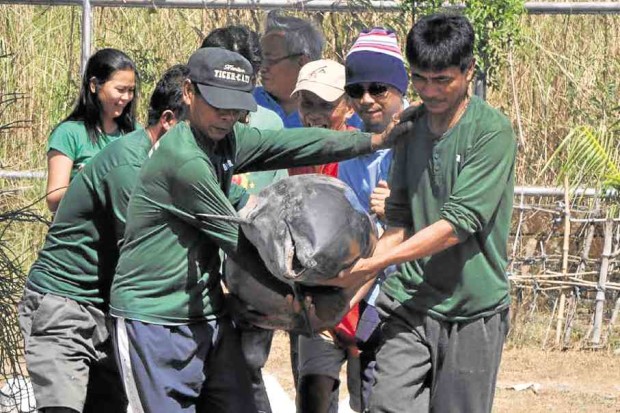Ilocos region top PH hot spot for sea mammal stranding

Workers of the Bureau of Fisheries and Aquatic Resources bring a dead dolphin to its grave at the Fish Cemetery in Dagupan City. —WILLIE LOMIBAO
VIGAN CITY—At dawn on Oct. 6, a melon-headed whale died right after it was taken from intensive care in a facility in Alaminos City. Hours later, a weak rough-toothed dolphin was found beached off Sto. Domingo town in Ilocos Norte province.
The two incidents occurred on the first day of a national symposium on marine mammals here, as if to emphasize the need to enhance sea environment protection to shield these animals from harm.
The Ilocos region is a hot spot in marine mammal stranding, topping all regions in the last 11 years. A total of 692 stranding incidents have been recorded since 2005, most involving spinner dolphins.
Worst year
Last year was the worst so far for animal stranding, with 112 marine mammals trapped or stranded, said Dr. Lemuel Aragones, president of the Philippine Marine Mammal Stranding Network (PMMSN).
There are several reasons marine mammals go to the beach. A 2010 study made by Aragones shows that sudden explosions from dynamite fishing give sea animals “acoustic trauma.”
Sea mammals, like whales, navigate by sending out sound pulses to find prey and determine their surroundings. When they lose their hearing, they lose their way, Aragones said.
Some animals suffer injuries because of fishing activities. Dolphins have been tangled in fishing nets or gears. Biotoxins and human interaction are also cited as reasons for the stranding.
But the Philippines also has a high rate of live stranding, a reference to sea animals who survive their ordeal at the shore.
Records show 65 percent of beached marine mammals were alive. Of the 692 stranded sea mammals in 11 years, 418 lived. A total of 187 survivors were released back to the sea after receiving supportive care.
“Globally, two or three sea animals are dead when they get to shore,” Aragones said.
Dramatic decline
This year, stranding cases have slid down dramatically, with only 51 beached sea animals recorded as of Oct 6.
Thirteen of these animals were found or treated in the Ilocos region.
The PMMSN said it has a 27 percent success rate in the rehabilitation of stranded marine mammals. The group has no funding, Aragones said, and is dependent on member agencies to subsidize projects to save sea animals.
The group said all regions should have a speed boat that would serve as an animal ambulance that could carry 3-meter long dolphins and whales. The Ilocos region has such an ambulance, which can be filled with water and is equipped with a stretcher.














